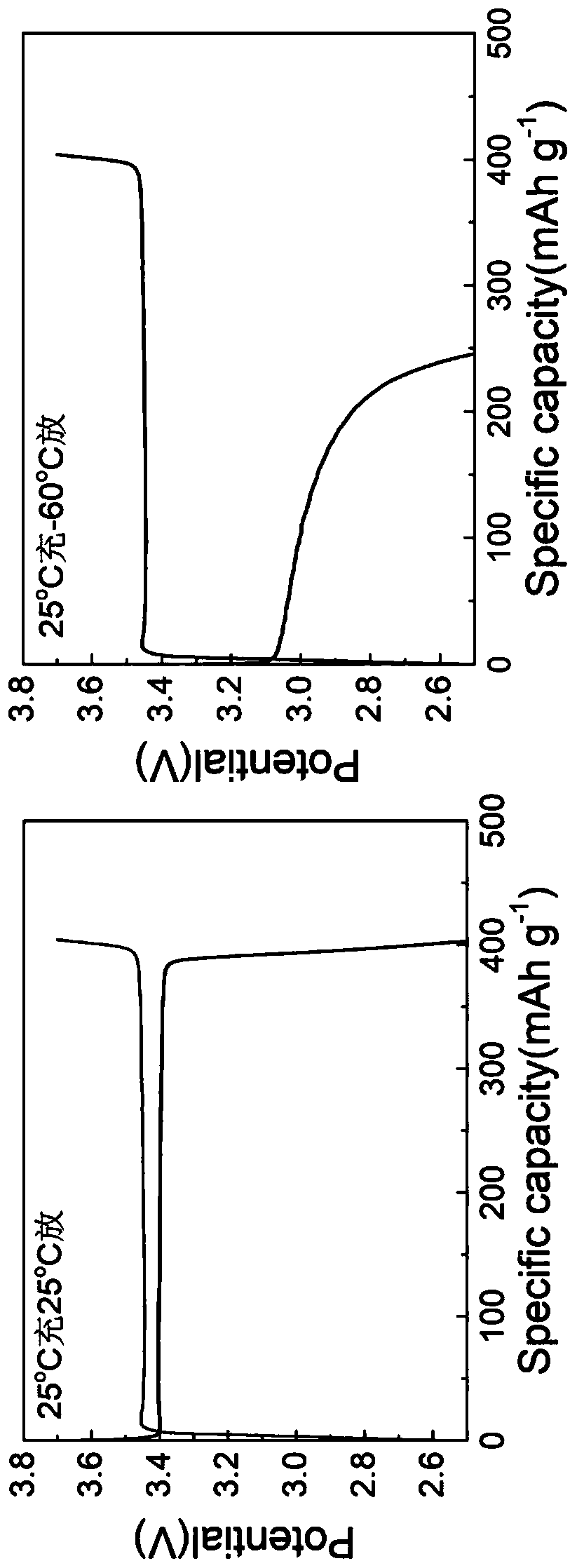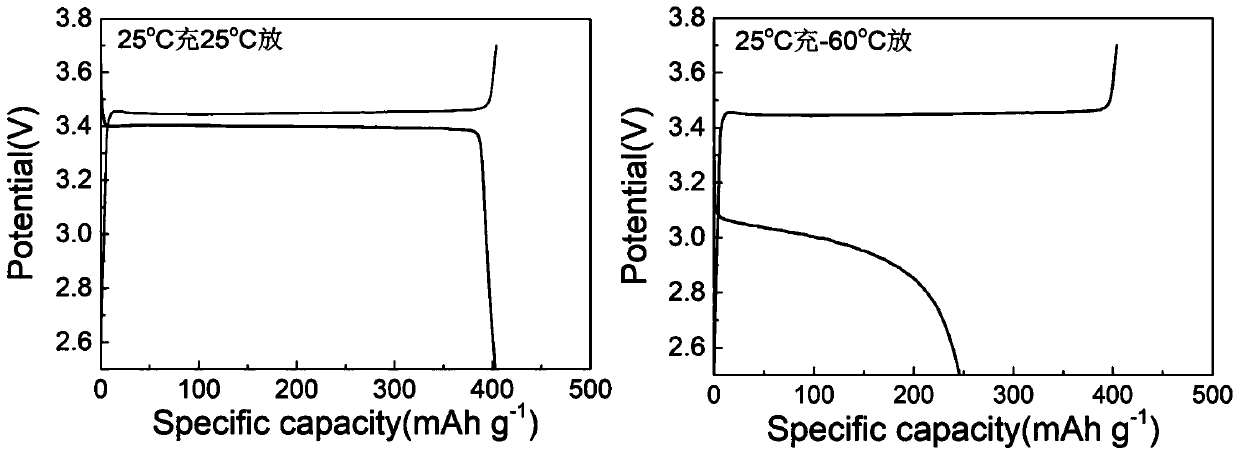Preparation method of ultralow-temperature lithium ion battery which can normally work at temperature of minus 60 DEG C
A lithium-ion battery, normal working technology, applied in battery electrodes, secondary batteries, circuits, etc., can solve problems such as low mobility of large ions, and achieve the effects of good rate performance, large capacity, and enhanced rate performance
- Summary
- Abstract
- Description
- Claims
- Application Information
AI Technical Summary
Problems solved by technology
Method used
Image
Examples
Embodiment 1
[0033] Preparation of positive electrode material: Weigh 5g of nano-lithium iron phosphate powder, 0.75g of tris buffering agent, and 1.35g of polyethylene oxide-polypropylene oxide-polyethylene oxide triblock copolymer, and mix them Put it into a large beaker and pour 1L of deionized water into it, and stir for 3 hours, and the stirring speed is 1500 rpm. Then add 1 g of dopamine hydrochloride and continue stirring for 24 hours. After the stirring is completed, carry out centrifugal washing, and carry out vacuum drying in a vacuum oven at 100° C. after washing. The described drying time is 8 hours. Carry out carbonization treatment on the dried sample. The carbonization condition is to raise the temperature to 400°C at 1°C / min, keep it warm for 1.5 hours, and then raise the temperature to 800°C at 5°C / min, and keep it warm for 2 hours; the positive electrode material is obtained.
[0034] Preparation of negative electrode material: Weigh polyacrylonitrile and configure it i...
Embodiment 2
[0038] Preparation of positive electrode material: Weigh 5g of nano-lithium iron phosphate powder, 1.5g of tris buffering agent, and 2.7g of polyethylene oxide-polypropylene oxide-polyethylene oxide triblock copolymer, and mix them Put it into a large beaker and pour 1L of deionized water into it, and stir for 5 hours, and the stirring speed is 2000 rpm. Then 2 g of dopamine hydrochloride was added and stirring was continued for 36 hours. After the stirring is completed, carry out centrifugal washing, and carry out vacuum drying in a vacuum oven at 100° C. after washing. The described drying time is 8 hours. Carry out carbonization treatment on the dried sample. The carbonization condition is to raise the temperature to 400°C at 1°C / min, keep it warm for 1.5 hours, and then raise the temperature to 800°C at 5°C / min, and keep it warm for 2 hours; the positive electrode material is obtained.
[0039] Preparation of negative electrode material: Weigh polyacrylonitrile to prepar...
Embodiment 3
[0043] Preparation of positive electrode material: Weigh 5g of nano-lithium iron phosphate powder, 0.75g of tris buffering agent, and 1.35g of polyethylene oxide-polypropylene oxide-polyethylene oxide triblock copolymer, and mix them Put it into a large beaker and pour 1L of deionized water into it, and stir for 3 hours, and the stirring speed is 1500 rpm. Then add 1 g of dopamine hydrochloride and continue stirring for 24 hours. After the stirring is completed, carry out centrifugal washing, and carry out vacuum drying in a vacuum oven at 100° C. after washing. The described drying time is 8 hours. Carry out carbonization treatment on the dried sample. The carbonization condition is to raise the temperature to 400°C at 1°C / min, keep it warm for 1.5 hours, and then raise the temperature to 800°C at 5°C / min, and keep it warm for 2 hours; the positive electrode material is obtained.
[0044] Preparation of negative electrode material: Weigh polyacrylonitrile to prepare a 30mL ...
PUM
| Property | Measurement | Unit |
|---|---|---|
| Particle size | aaaaa | aaaaa |
Abstract
Description
Claims
Application Information
 Login to View More
Login to View More - R&D Engineer
- R&D Manager
- IP Professional
- Industry Leading Data Capabilities
- Powerful AI technology
- Patent DNA Extraction
Browse by: Latest US Patents, China's latest patents, Technical Efficacy Thesaurus, Application Domain, Technology Topic, Popular Technical Reports.
© 2024 PatSnap. All rights reserved.Legal|Privacy policy|Modern Slavery Act Transparency Statement|Sitemap|About US| Contact US: help@patsnap.com









